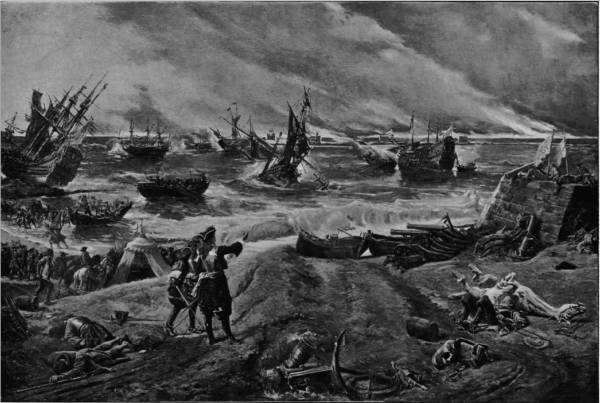

The quotations at the head of each section are taken from Graves' list of Royal Academy exhibitors, and represent the inspiration for the painting, as submitted to the Academy's catalogue by Eyre Crowe.

Title: James II at La Hogue, May, 1692 (1898)
Medium: oil
Size: 39 x 58½ inches
Exhibited: Royal Academy, 1898
'The French mariners often went off undisturbed in their boats from one side of the ship, whilst the English had entered and were destroying the other. During the action a generous exclamation burst from James, for when he first saw the seamen in swarms scrambling up the high sides of the French ships from their boats, he cried, 'Ah! none but my brave English could do so brave an action'

Reproduced in Royal Academy Pictures, 1898, p. 171
------------------
The battlefield scene, unusual for Crowe, was possibly inspired by the positive public reaction to similar paintings which Crowe observed at the Victorian Era Exhibition in June 1896. His friend Jean-Léon Gérôme had a 'beautiful' model of a gunship, which Crowe painted and arranged to have photographed during a visit to Paris in summer 1897, and Gérôme also gave Crowe much helpful advice on the composition. The final picture was affected by the well-meaning actions of James Clarke Hook RA (1819-1907) on one of the Varnishing Days at the Royal Academy, who, according to Eyre Crowe's diary, went over the waves and the principal figure of James II with a palette-knife, exclaiming 'I'll eat my 'Ead off, if that aint a great improvement!' Crowe wrote that he was 'so dazed that I left my work thus smudged over, conscious that the work was less gawdy; but also less neat than it should be!'
This painting was one of those remaining in Eyre Crowe's possession at his death, and was sold for £8 8s at an auction of his remaining works at Christie's in London on 18 March 1911.

Title: The Way to the Farm (1899)
Medium: oil
Size: 28 x 42 inches
Exhibited: Royal Academy, 1899; Liverpool, 1899

Reproduced in Royal Academy Pictures, 1899, p. 73
Athenaeum, 27 May 1899:
Let us ... commend Mr. Crowe's rustic theme in The Way to the Farm (72), which shows the artist almost equal to the work of his earlier years.
------------------
The picture depicts a roadway descending into the Vallée de Denacre opposite Chateau de l'Espagnerie near Boulogne, which Crowe visited in the late summer of 1898.
It was highly praised by Crowe's Royal Academy friends, including Luke Fildes, T. Armstrong and Woods, and George Dunlop Leslie advised Crowe to take up landscape painting rather than figure painting, as the pictures would be certain to sell; however, this painting, then called A Country Lane, was one of those remaining in Eyre Crowe's possession at his death, and was sold for £5 15 6 at an auction of his remaining works at Christie's in London on 18 March 1911.

Title: On the Boulogne Ramparts (1899)
Medium: oil
Size: 27½ x 35 inches
Exhibited: Royal Academy, 1899; Liverpool, 1899
'There are few prospects more charming than the familiar view from these old French walls' - Thackeray

Reproduced in Royal Academy Pictures, 1899, p. 188
Athenaeum, 27 May 1899:
... his On the Boulogne Ramparts (97) indicates a considerable recovery of the powers which have given us many a sincere and soundly painted piece of genre.
------------------
Crowe initially sketched and painted this picture in situ in Boulogne in the summer of 1898, and asked his niece Viccy Wilkinson to stand for the principal female figure back in London at the beginning of 1899. This painting was one of those remaining in Eyre Crowe's possession at his death, and was sold for £1 11 6 at an auction of his remaining works at Christie's in London on 18 March 1911.

Title: J.F. Millet in his Studio at Barbizon (1899)
Medium: oil
Size: 10 x 14 inches
Exhibited: Royal Academy, 1899; Manchester, 1899

Reproduced in Royal Academy Pictures,
1899, p. 113
Athenaeum, 27 May 1899:
Mr E. Crowe's J F Millet in his studio at Barbizon (810) is a well-painted sunlit interior, with an interest beyond its art.

Title: Crossing the Brook (1899)
Medium: oil
Size: 10 x 14 inches
Exhibited: Royal Academy, 1899; Manchester, 1899

Reproduced in Royal Academy Pictures, 1899, p. 45
------------------
This scene was begun in the Laclose Valley near Boulogne in October 1898. The woman carrying a child was drawn from the 'slatternly peasant woman', as Eyre Crowe described her, living in a nearby farmhouse.


Copyright (c) 2005 Kathryn J. Summerwill. All rights reserved.






